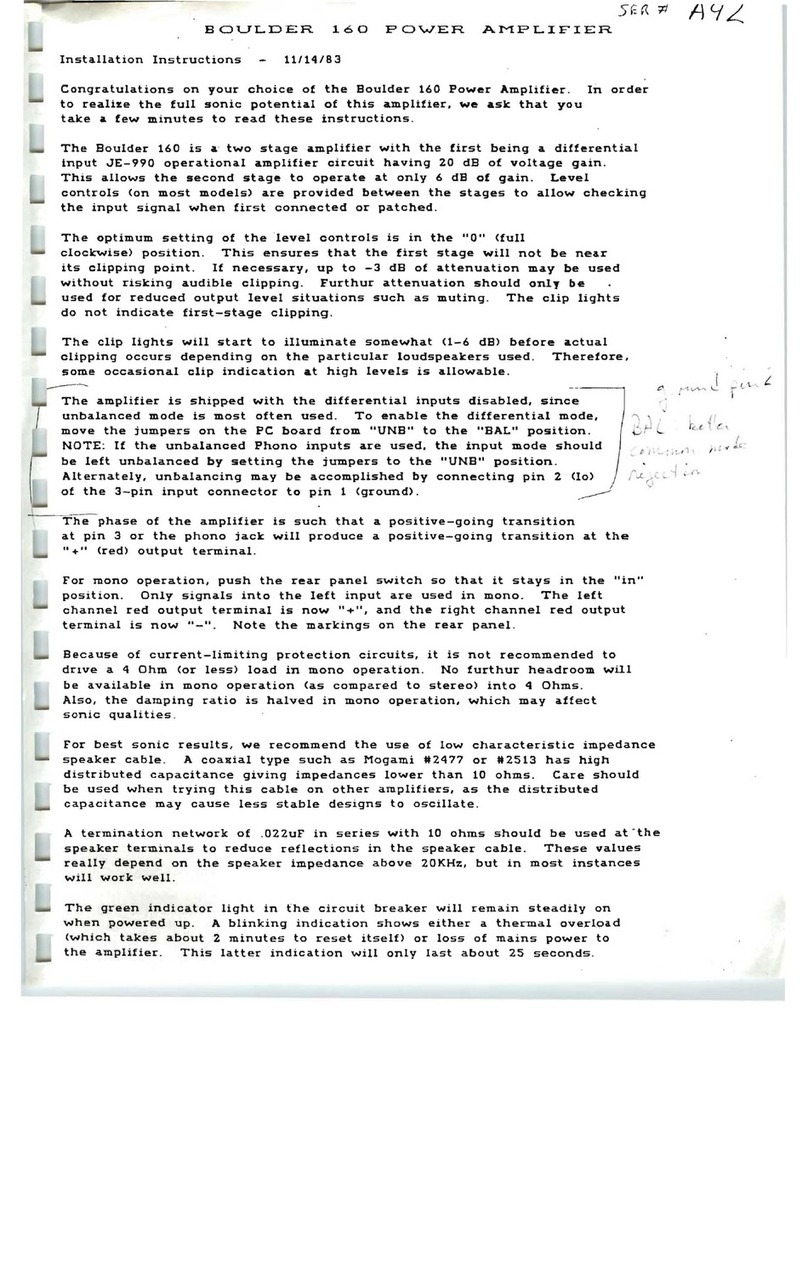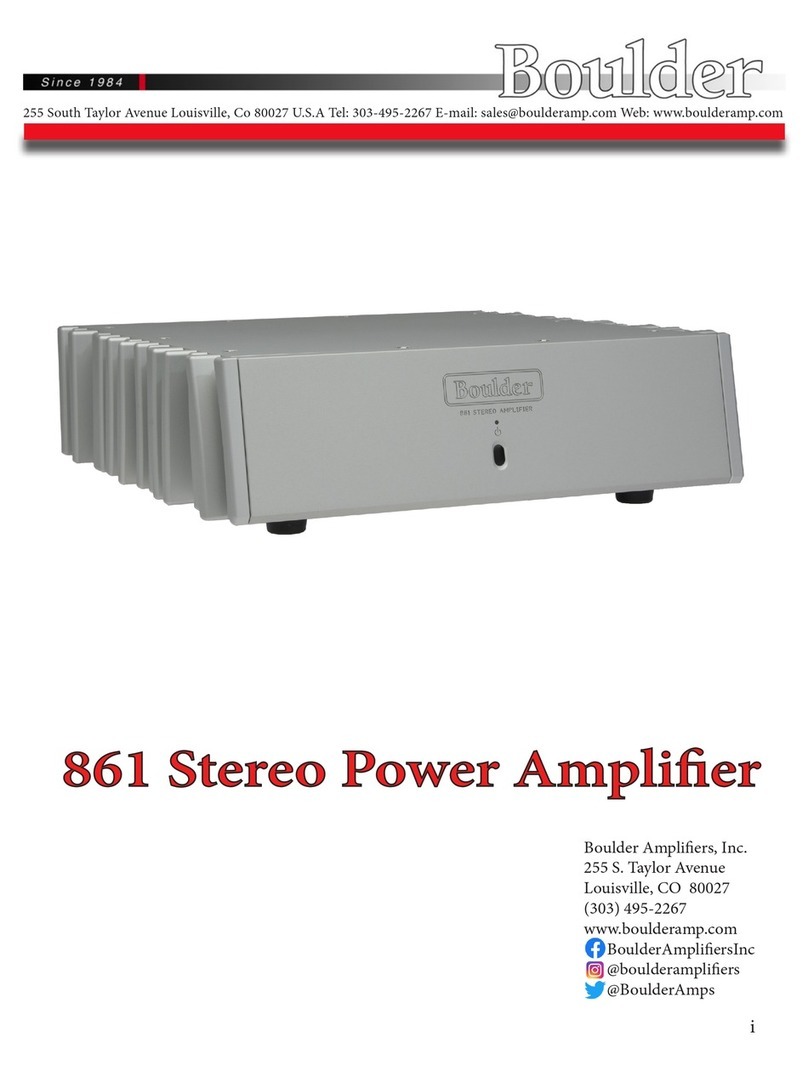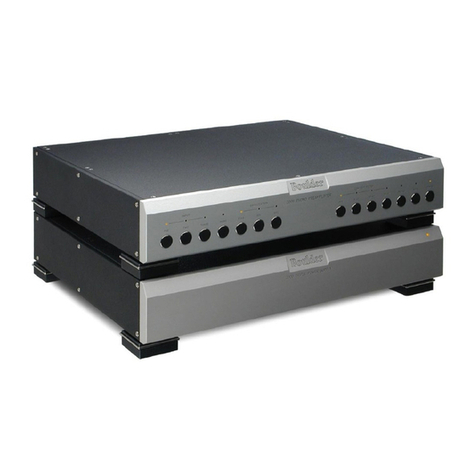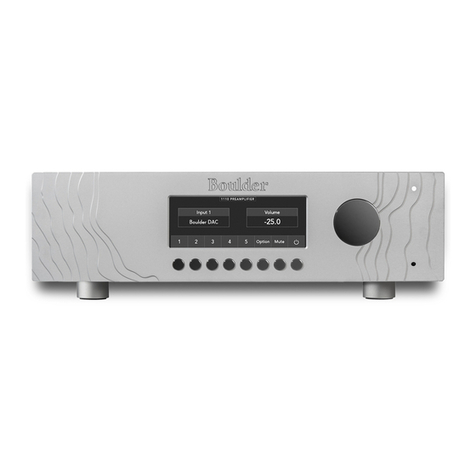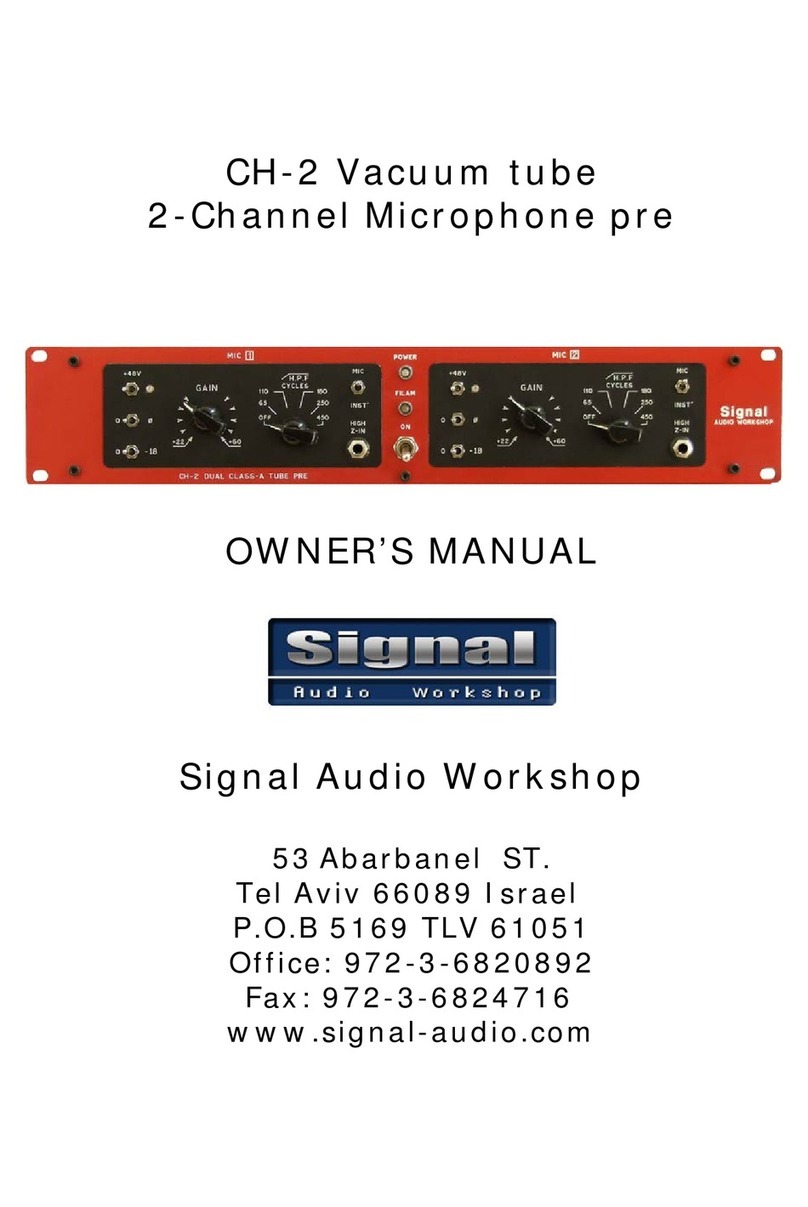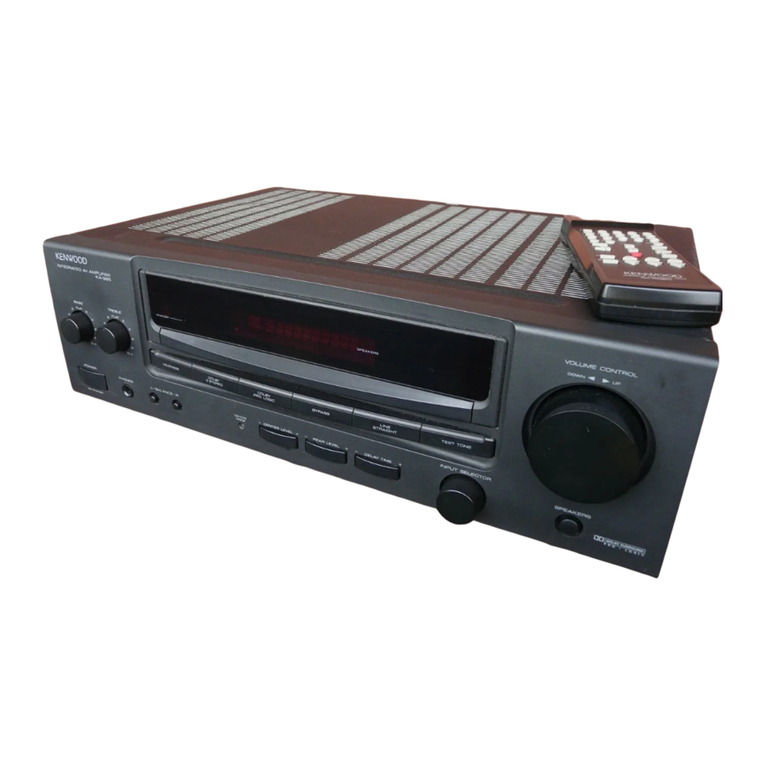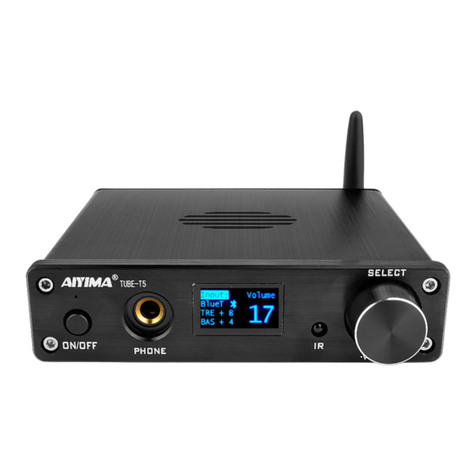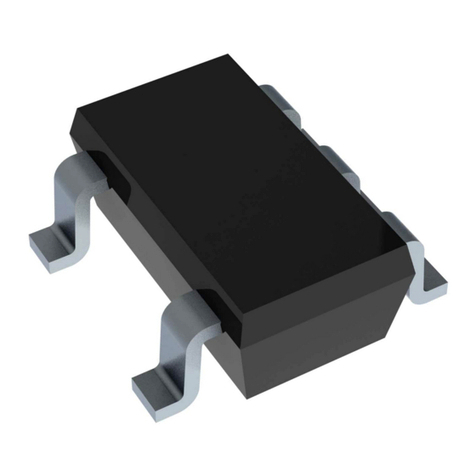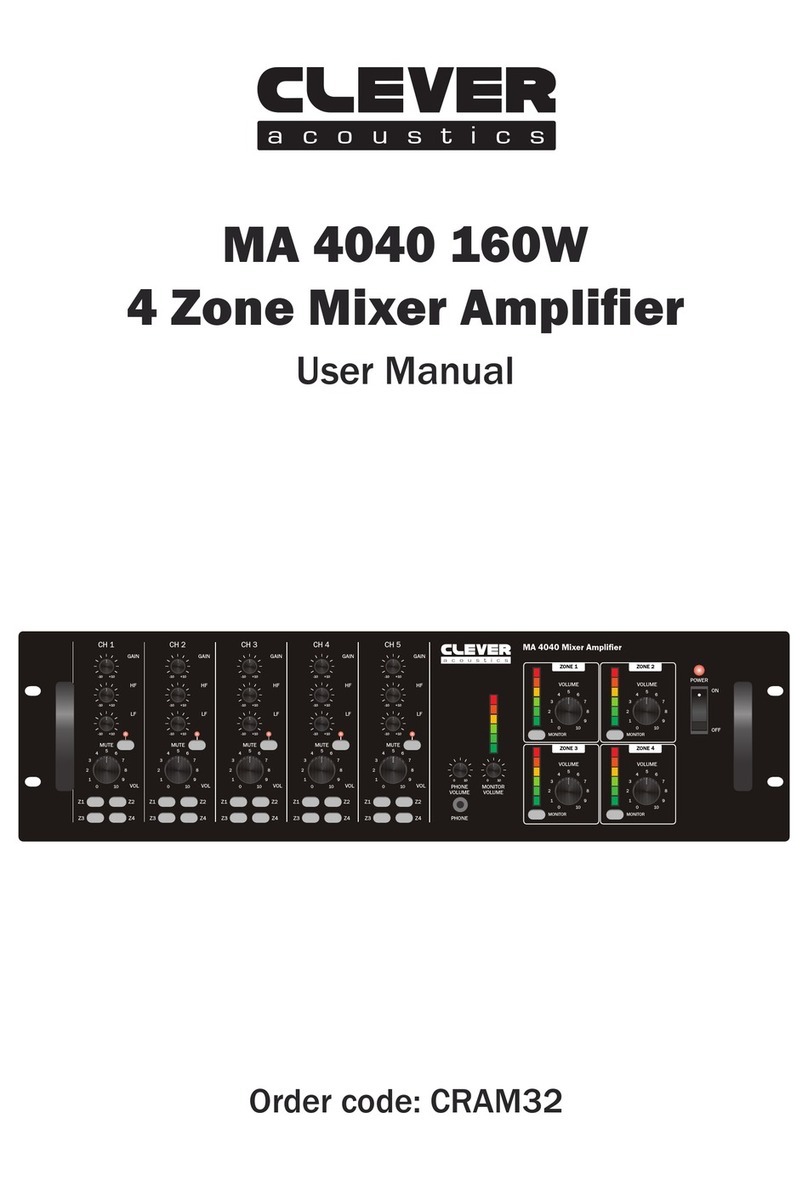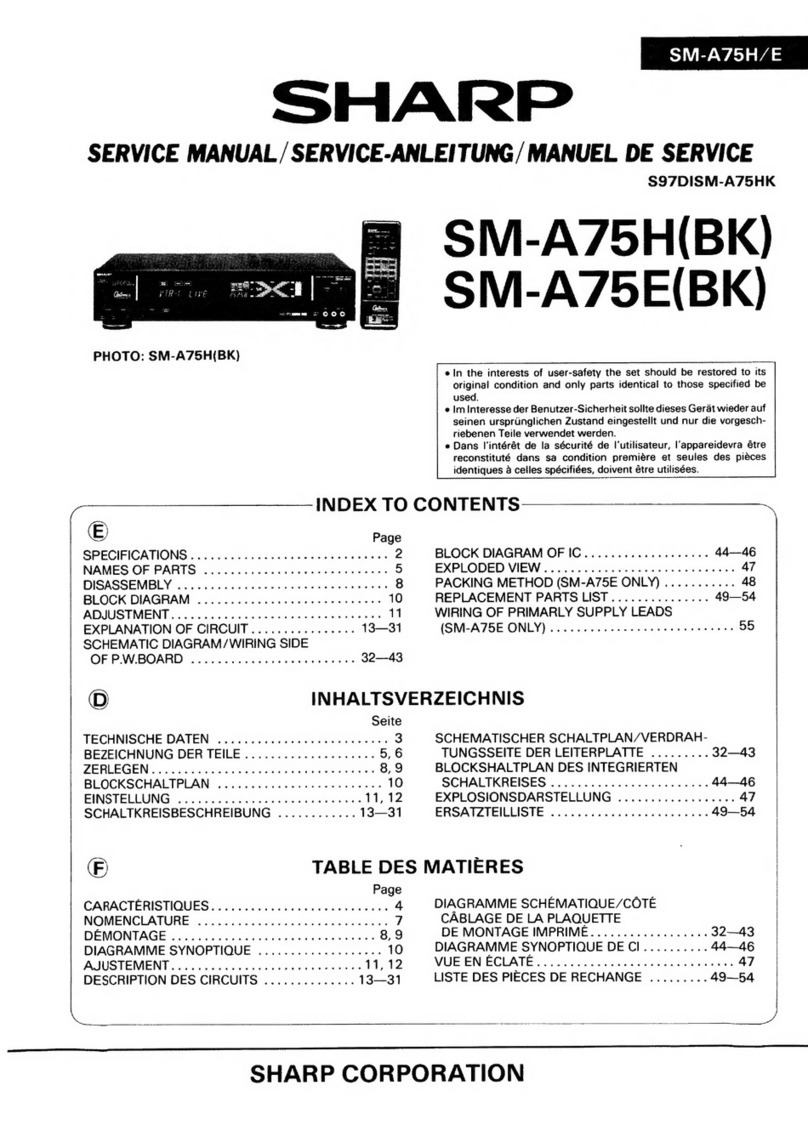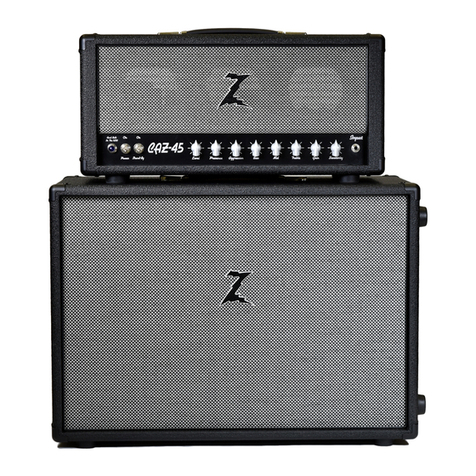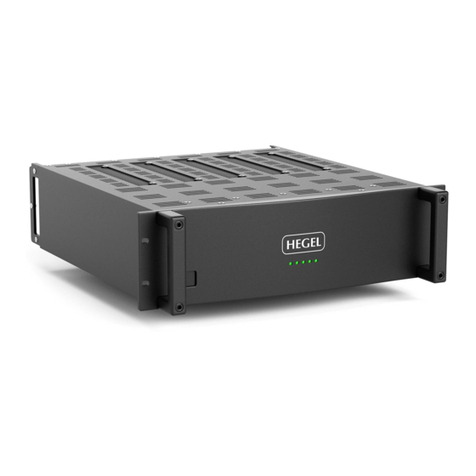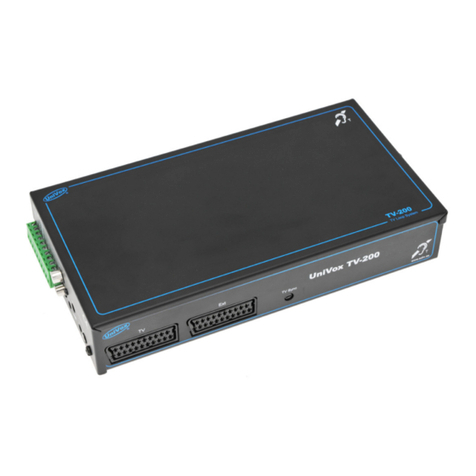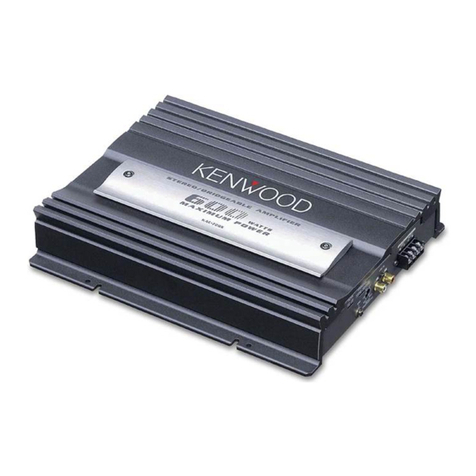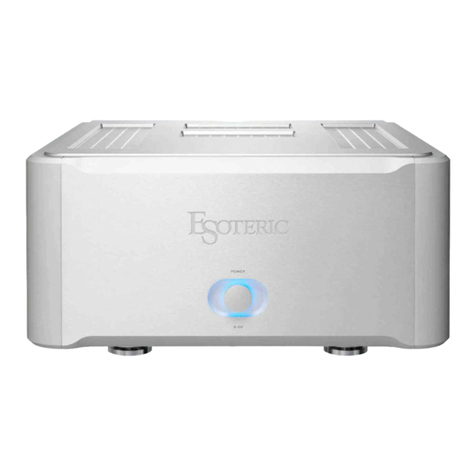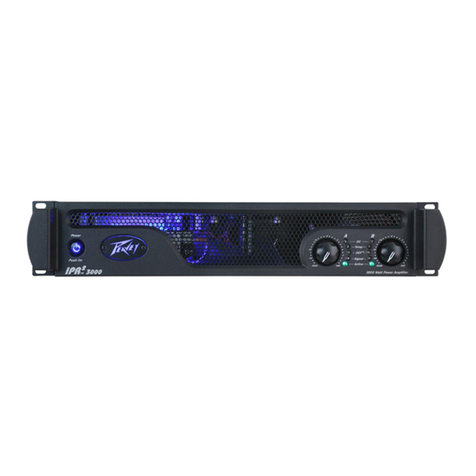Boulder 1012 DAC Preamplifier User manual


Boulder
1012 DAC Preamplifier
Owners Manual
10/27/03
Boulder Amplifiers, Inc.
3235 Prairie Ave.
Boulder, CO 80301
www.boulderamp.com
APPENDIX RECORDING
BOULDER
LINK
PROGRAMMING
REMOTE
CONTROL OPERATION
GETTING
STARTED

Boulder 1012 DAC Preamplifier Rear Panel

TABLE OF CONTENTS
GETTING STARTED
Introduction . . . . . . . . . . . . . . . . . . . . . . . . . . . . . . . . . . . . . . . . . . . . . . . . . . . . . . . . . . . . . . . 1-1
Quick Start . . . . . . . . . . . . . . . . . . . . . . . . . . . . . . . . . . . . . . . . . . . . . . . . . . . . . . . . . . . . . . . . 1-1
Placement of the 1012 DAC Preamplifier . . . . . . . . . . . . . . . . . . . . . . . . . . . . . . . . . . . . . . 1-2
Connecting to the Mains Outlet . . . . . . . . . . . . . . . . . . . . . . . . . . . . . . . . . . . . . . . . . . . . . . 1-3
Connecting a Digital Source. . . . . . . . . . . . . . . . . . . . . . . . . . . . . . . . . . . . . . . . . . . . . . . . . . 1-4
Polarity . . . . . . . . . . . . . . . . . . . . . . . . . . . . . . . . . . . . . . . . . . . . . . . . . . . . . . . . . . . . . . . . . . . 1-5
Connecting a Balanced Analog Source. . . . . . . . . . . . . . . . . . . . . . . . . . . . . . . . . . . . . . . . . 1-5
Connecting an Unbalanced Analog Source . . . . . . . . . . . . . . . . . . . . . . . . . . . . . . . . . . . . . 1-6
Connecting a Turntable. . . . . . . . . . . . . . . . . . . . . . . . . . . . . . . . . . . . . . . . . . . . . . . . . . . . . . 1-7
Connecting to a Balanced Input Amplifier . . . . . . . . . . . . . . . . . . . . . . . . . . . . . . . . . . . . . 1-9
Connecting to an Unbalanced Input Amplifier . . . . . . . . . . . . . . . . . . . . . . . . . . . . . . . . 1-10
Setting the Boulderlink Switch . . . . . . . . . . . . . . . . . . . . . . . . . . . . . . . . . . . . . . . . . . . . . . 1-11
OPERATION
Powering Up. . . . . . . . . . . . . . . . . . . . . . . . . . . . . . . . . . . . . . . . . . . . . . . . . . . . . . . . . . . . . . . 2-1
Input Selections . . . . . . . . . . . . . . . . . . . . . . . . . . . . . . . . . . . . . . . . . . . . . . . . . . . . . . . . . . . . 2-2
Volume. . . . . . . . . . . . . . . . . . . . . . . . . . . . . . . . . . . . . . . . . . . . . . . . . . . . . . . . . . . . . . . . . . . . 2-4
Balance. . . . . . . . . . . . . . . . . . . . . . . . . . . . . . . . . . . . . . . . . . . . . . . . . . . . . . . . . . . . . . . . . . . . 2-5
Mute. . . . . . . . . . . . . . . . . . . . . . . . . . . . . . . . . . . . . . . . . . . . . . . . . . . . . . . . . . . . . . . . . . . . . . 2-6
Display. . . . . . . . . . . . . . . . . . . . . . . . . . . . . . . . . . . . . . . . . . . . . . . . . . . . . . . . . . . . . . . . . . . . 2-7
APPENDIX RECORDING
BOULDER
LINK
PROGRAMMING
REMOTE
CONTROL OPERATION
GETTING
STARTED

REMOTE CONTROL
Batteries. . . . . . . . . . . . . . . . . . . . . . . . . . . . . . . . . . . . . . . . . . . . . . . . . . . . . . . . . . . . . . . . . . . 3-1
Source Selection . . . . . . . . . . . . . . . . . . . . . . . . . . . . . . . . . . . . . . . . . . . . . . . . . . . . . . . . . . . . 3-2
Volume, Balance and Mute. . . . . . . . . . . . . . . . . . . . . . . . . . . . . . . . . . . . . . . . . . . . . . . . . . . 3-2
Polarity . . . . . . . . . . . . . . . . . . . . . . . . . . . . . . . . . . . . . . . . . . . . . . . . . . . . . . . . . . . . . . . . . . . 3-3
PROGRAMMING
Input Names. . . . . . . . . . . . . . . . . . . . . . . . . . . . . . . . . . . . . . . . . . . . . . . . . . . . . . . . . . . . . . . 4-1
Input Polarity . . . . . . . . . . . . . . . . . . . . . . . . . . . . . . . . . . . . . . . . . . . . . . . . . . . . . . . . . . . . . . 4-2
Theater Mode . . . . . . . . . . . . . . . . . . . . . . . . . . . . . . . . . . . . . . . . . . . . . . . . . . . . . . . . . . . . . . 4-3
Input Level Calibration. . . . . . . . . . . . . . . . . . . . . . . . . . . . . . . . . . . . . . . . . . . . . . . . . . . . . . 4-3
Input Balance Calibration. . . . . . . . . . . . . . . . . . . . . . . . . . . . . . . . . . . . . . . . . . . . . . . . . . . . 4-4
Main Outputs Polarity . . . . . . . . . . . . . . . . . . . . . . . . . . . . . . . . . . . . . . . . . . . . . . . . . . . . . . 4-5
Boulderlink ID . . . . . . . . . . . . . . . . . . . . . . . . . . . . . . . . . . . . . . . . . . . . . . . . . . . . . . . . . . . . . 4-6
Remote ID . . . . . . . . . . . . . . . . . . . . . . . . . . . . . . . . . . . . . . . . . . . . . . . . . . . . . . . . . . . . . . . . . 4-6
Master Reset . . . . . . . . . . . . . . . . . . . . . . . . . . . . . . . . . . . . . . . . . . . . . . . . . . . . . . . . . . . . . . . 4-7
BOULDERLINK
Connecting the Boulderlink . . . . . . . . . . . . . . . . . . . . . . . . . . . . . . . . . . . . . . . . . . . . . . . . . . 5-1
Setting Boulderlink Switches . . . . . . . . . . . . . . . . . . . . . . . . . . . . . . . . . . . . . . . . . . . . . . . . . 5-2
Setting Boulderlink ID Numbers. . . . . . . . . . . . . . . . . . . . . . . . . . . . . . . . . . . . . . . . . . . . . . 5-2
Power up via Boulderlink . . . . . . . . . . . . . . . . . . . . . . . . . . . . . . . . . . . . . . . . . . . . . . . . . . . 5-3
Boulderlink Messages . . . . . . . . . . . . . . . . . . . . . . . . . . . . . . . . . . . . . . . . . . . . . . . . . . . . . . . 5-4
APPENDIX RECORDING
BOULDER
LINK
PROGRAMMING
REMOTE
CONTROL OPERATION
GETTING
STARTED

RECORDING
Connecting a Recording Device . . . . . . . . . . . . . . . . . . . . . . . . . . . . . . . . . . . . . . . . . . . . . . 6-1
APPENDIX
Block Diagram . . . . . . . . . . . . . . . . . . . . . . . . . . . . . . . . . . . . . . . . . . . . . . . . . . . . . . . . . . . . . 7-1
Specifications . . . . . . . . . . . . . . . . . . . . . . . . . . . . . . . . . . . . . . . . . . . . . . . . . . . . . . . . . . . . . . 7-2
Troubleshooting . . . . . . . . . . . . . . . . . . . . . . . . . . . . . . . . . . . . . . . . . . . . . . . . . . . . . . . . . . . . 7-4
Notes . . . . . . . . . . . . . . . . . . . . . . . . . . . . . . . . . . . . . . . . . . . . . . . . . . . . . . . . . . . . . . . . . . . . . 7-5
APPENDIX RECORDING
BOULDER
LINK
PROGRAMMING
REMOTE
CONTROL OPERATION
GETTING
STARTED

GETTING STARTED
INTRODUCTION
Congratulations on your selection of the Boulder 1012 DAC
Preamplifier. We at Boulder Amplifiers are certain it will provide years
of listening pleasure.
QUICK START
To get started listening, you only need to connect the 1012 as
you would any other preamplifier, but you should take note of the
following.
WARNING: The polished volume control is attractive and because it
is optical and has no stops, it is really tempting to just spin it around. DO
THIS ONLY WITH THE POWER OFF! It must be given the respect you
would any other volume control with its ability to get loud very quickly.
By the time you have turned it up to -40.0 dB with a source turned on,
you should be hearing some music. If not, don’t proceed any louder until
you have solved the problem. See trouble shooting section.
For the 1012 to work properly, the Boulderlink’s MASTER/SLAVE
switch should be set to MASTER.
A thorough reading of this manual will definitely enhance your
enjoyment of your 1012 DAC Preamplifier.
GETTING
STARTED
1-1

PLACEMENT OF THE 1012 DAC PREAMPLIFIER
Your Boulder 1012 DAC Preamplifier is designed to reduce the
effects that external magnetic and radio fields (RF) have on its internal
circuitry. While placement is not critical, known magnetic fields should
be avoided. Line of sight from the listening position is necessary for the
remote control to function properly.
Because the preamplifier is heavy, a solid, stable surface should be
used. As it will generate some heat, there should be good air circulation
around it. In particular, make certain that the power supply heat sink
fins on the rear of the chassis are not blocked.
You may want to have some access to the rear panels for cable
changes.
GETTING
STARTED
1-2

CONNECTING TO THE MAINS OUTLET
Your 1012 DAC Preamplifier is supplied with a mains cord suitable
to the location where it was purchased.
A label showing the exact voltage and frequency range is located
on the rear panel. Make certain that the mains voltage used is with in
the specifications shown. Also listed are the fuse ratings. There are two
fuse holders on the rear of the 1012 which are for each of the digital and
analog power transformers.
Use only specified fuses. Check with qualified service person first.
GETTING
STARTED
1-3

CONNECTING A DIGITAL SOURCE
There are four digital inputs to the DSP and D/A Converter section
of the 1012. Three inputs are the AES/EBU style. Because of the balanced
nature of these connections, it is the preferred method of connection and
should be used whenever available.
With the 1012, one DABL digital adapter is supplied and may be
plugged into any one of these inputs thus converting it to RCA phono
style SPDIF. Additional adapters are available if more than one input
needs conversion.
WARNING: In order to maintain proper impedance and level
matching, it is important to always use the DABL adapter when coming
from an unbalanced RCA phono style digital source. Do not use a
Boulder ABL analog adapter for this purpose.
The fourth connector normally supplied is toslink optical.
For possible future connections, consult your Boulder dealer.
GETTING
STARTED
1-4

POLARITY
Please note that the 1012 DAC Preamplifier conforms to the standard
of pin 2 as the high or hot pin for all analog balanced inputs and outputs.
Because input and output polarities are handled through programming
setups and the remote control, no concern for polarity is needed while
connecting sources.
Digital connectors have no polarity.
CONNECTING A BALANCED ANALOG SOURCE
To fully realize the sonic potential of your 1012 DAC Preamplifier,
use balanced connections whenever possible. Balanced cables reduce
interference from magnetic and RF sources to an absolute minimum.
Connect each line source to one of the three inputs provided. Later,
you will be able to name each input with the source’s name, so you
might want to make a list as you connect them.
GETTING
STARTED
1-5

CONNECTING AN UNBALANCED ANALOG SOURCE
Although the inputs are all of the 3 pin type, an unbalanced source
is easily accommodated by using a special cable. This cable has an RCA
phono type connector on the source end and a 3 pin connector for going
to an input on the 1012 DAC Preamplifier.
The minus input (pin 3) should be wired to ground only at the RCA
phono connector. This brings the minus input reference of the 1012 to the
unbalanced source ground, thus reducing ground loops.
Another option for accommodating unbalanced sources is that of the
Boulder ABL analog input adapter. It converts a balanced input into a
RCA phono input right at the rear of the 1012.
Like the above cable, the minus input of the 1012 is connected to
the ground of the RCA phono. However, this minus side will then share
the shield wire with the chassis ground and will not have the best hum
rejection.
GETTING
STARTED
1-6
UNBALANCED INPUT CABLE
3-NEG INPUT
2-POS INPUT
1-GROUND

CONNECTING A TURNTABLE
Balanced inputs are provided for connecting a turntable to the 1012.
To avoid hum pickup in the cabling, it is important to follow these
instructions.
Do not connect pin 1 (chassis/ground) to either pin 2 or 3 at any
point in the cable, turntable chassis, or tonearm. Pins 2 and 3 must only
connect directly to the cartridge pins. This can be accomplished by
several wiring schemes shown on the next page.
Do not use the Boulder ABL input adapter or other RCA Phono to
XLR adapter.
Use either a connection from pin 1 to the turntable chassis or wire
from the CHASSIS screw terminal to the turntable chassis, but do not
use both.
For high level, moving magnet (MM) type cartridges, set the LEVEL
switch to HIGH. For low level, moving coil (MC) type cartridges, set the
LEVEL switch to LOW.
If in doubt, consult your Boulder dealer.
GETTING
STARTED
1-7

1-8
PHONO CABLES
CARTRIDGE 1012 PHONO INPUT
TURNTABLE CHASSIS
3-POS INPUT
2-POS INPUT
1-POS INPUT
CHASSIS
CARTRIDGE 1012 PHONO INPUT
TURNTABLE CHASSIS
3-POS INPUT
2-POS INPUT
1-POS INPUT
CHASSIS
CARTRIDGE 1012 PHONO INPUT
TURNTABLE CHASSIS
3-POS INPUT
2-POS INPUT
1-POS INPUT
CHASSIS
N.C.
GETTING
STARTED

CONNECTING TO A BALANCED INPUT AMPLIFIER
With your 1012 DAC Preamplifier’s balanced output driving a
balanced input power amplifier, you can take sonic advantage of short
speaker cables and correspondingly longer input cables. With the 1012’s
low output impedance, distances of more than 50 meters between
preamplifier and power amplifier are practical.
Connect each amplifier input to the main outputs labeled “MAIN
OUT.” If it is desired to use 2 or more amplifiers such as in bi-amping,
splitters will be required. If in doubt, consult your Boulder dealer.
GETTING
STARTED
1-9

CONNECTING TO AN UNBALANCED INPUT AMPLIFIER
A special cable is required to make this connection. This cable
connects pin 1 to the shield and pin 2 to the center pin. It leaves the
output pin 3 unconnected.
Connecting the unused output pin (usually pin 3) to ground will
cause excessive ground currents and degrade performance. Use an
ohmmeter or continuity checker to determine how a cable is wired.
GETTING
STARTED
1-10
UNBALANCED OUTPUT CABLE
3-NEG OUTPUT
2-POS OUTPUT
1-GROUND
LINE
PREAMP
INPUT

SETTING THE BOULDERLINK SWITCH
Set the Boulderlink MASTER / SLAVE switch to MASTER.
For more information on Boulderlink, see the Boulderlink section as
indicated by the finger tabs below.
GETTING
STARTED
1-11

OPERATION
POWERING UP
With all your connections made, you are ready to listen to your
Boulder 1012 DAC Preamplifier.
The power LED will cycle through a variety of colors indicating a
standby mode. Power is applied only to the microprocessor during this
mode.
Press the POWER button to turn on the 1012. The indicator will
change to amber and power will be applied to the analog audio section.
If a digital input was previously selected, power will also be applied to
the DSP, D/A Converter, and analog low-pass filter sections which are
used only for digital signals.
During the power up sequence, the displays at left will be briefly
shown.
The front panel POWER button should be used for everyday turn
on and off. This switch mutes the audio, turns off all sections except the
microprocessor, and puts the preamplifier in a standby mode.
2-1
OPERATION

INPUT SELECTIONS
To select an analog input, press one of the ANALOG pushbuttons
labeled ONE, TWO, THREE or PHONO. The respective input will be
shown in the display and that signal will be routed to both the main and
record outputs. For example, if input ONE is chosen, “A1. ANALOG
INPUT 1” will show in the display.
NOTE: There will be a 1 second delay when switching from one
source to another. This is necessary to allow the circuitry to adjust to the
new input source.
OPERATION
2-2

To select a digital input, press one of the DIGITAL pushbuttons
labeled ONE through FOUR. For a few seconds, the input sample rate
of the source and the Upandoversampling™ rate out of the DSP will be
shown. For example, a regular CD will show “INPUT RATE 44.1kHz,
OUTPUT RATE 705.6kHz.”
The “INPUT RATE” is the rate at which the 1012 receives data from
the source. The “OUTPUT RATE” is the rate at which the 1012’s Digital
Signal Processor (DSP) sends data to the converters. The ratio of these
two numbers is the amount of Upandoversampling™ performed by the
DSP.
Then the respective input will be shown in the display and that signal
will be routed to both the main and record outputs. For example, if input
ONE is chosen, “D1. DIGITAL INPUT 1” will show in the display.
OPERATION
2-3
This manual suits for next models
1
Table of contents
Other Boulder Amplifier manuals
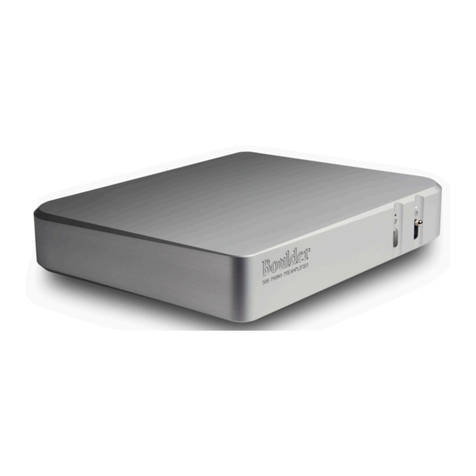
Boulder
Boulder 508 User manual
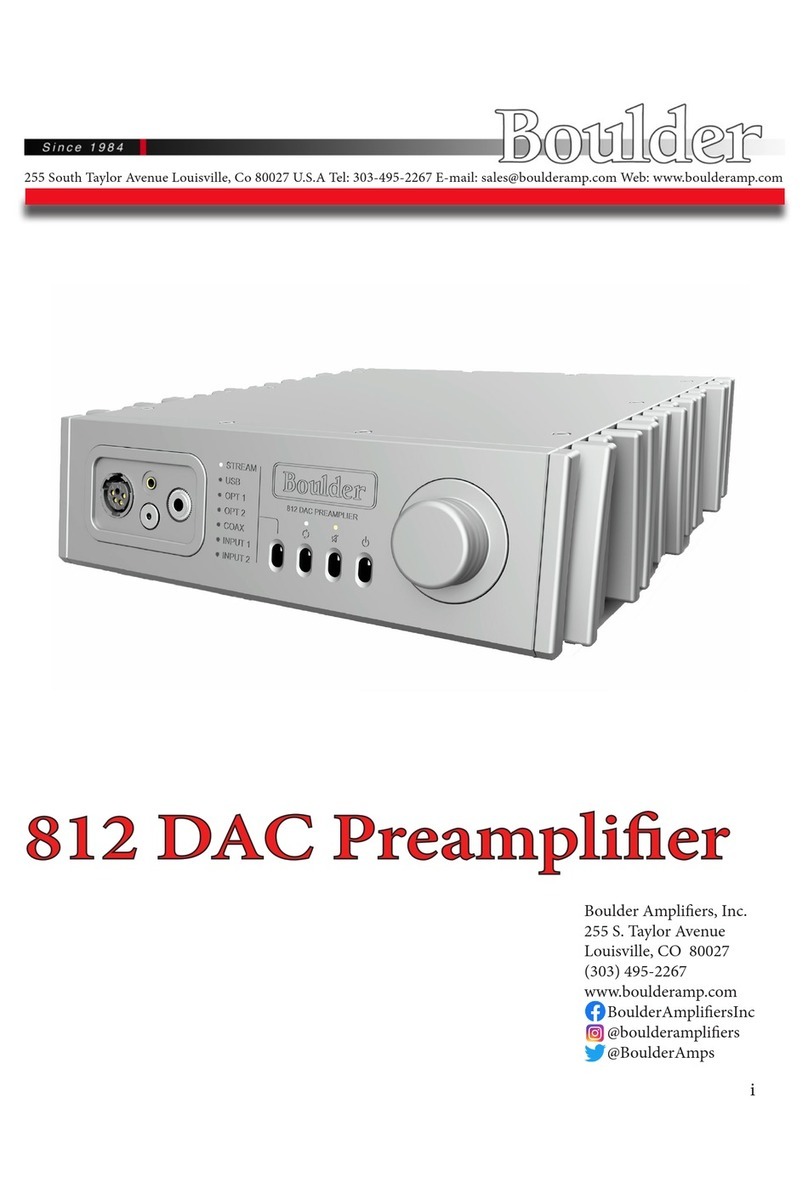
Boulder
Boulder 812 User manual
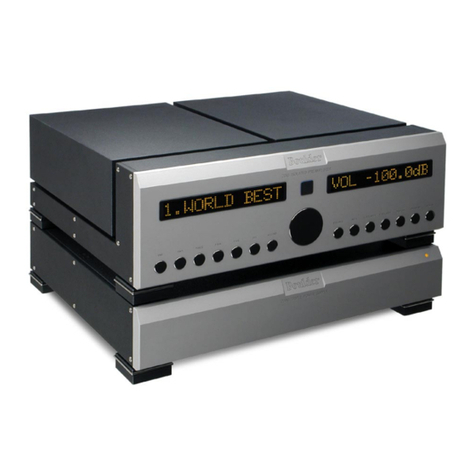
Boulder
Boulder 2010 User manual
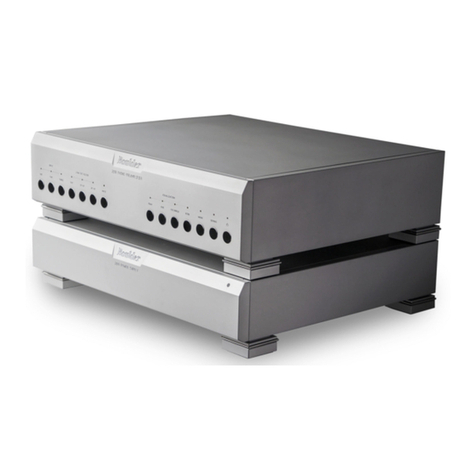
Boulder
Boulder 2108 User manual
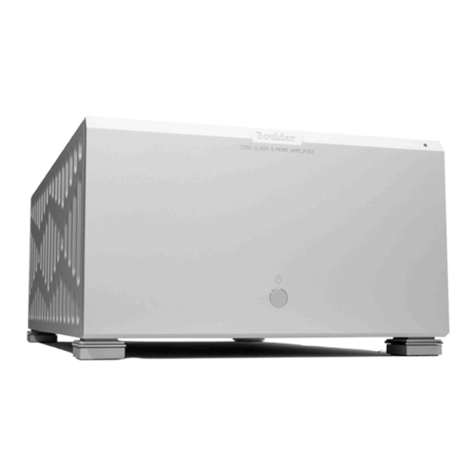
Boulder
Boulder 2150 User manual
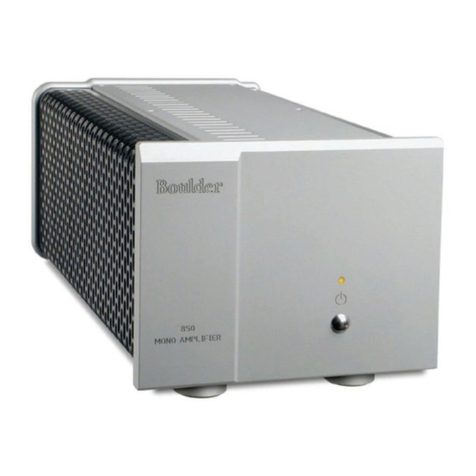
Boulder
Boulder 850 User manual
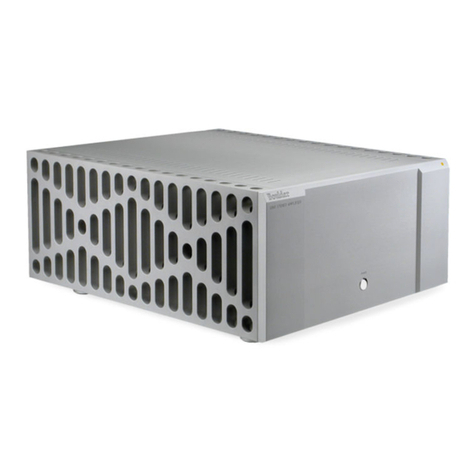
Boulder
Boulder 1060 User manual
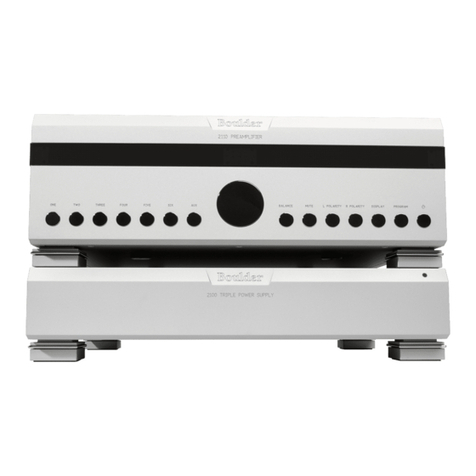
Boulder
Boulder 2110 User manual

Boulder
Boulder 1160 User manual
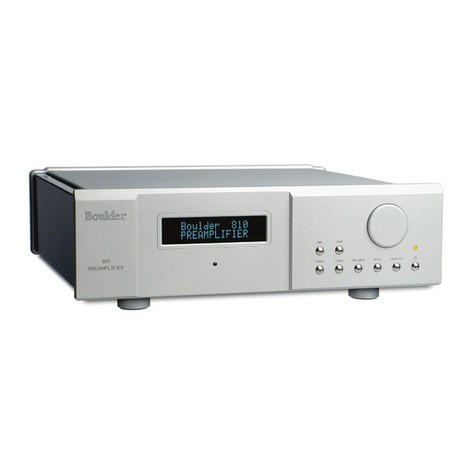
Boulder
Boulder 810 User manual
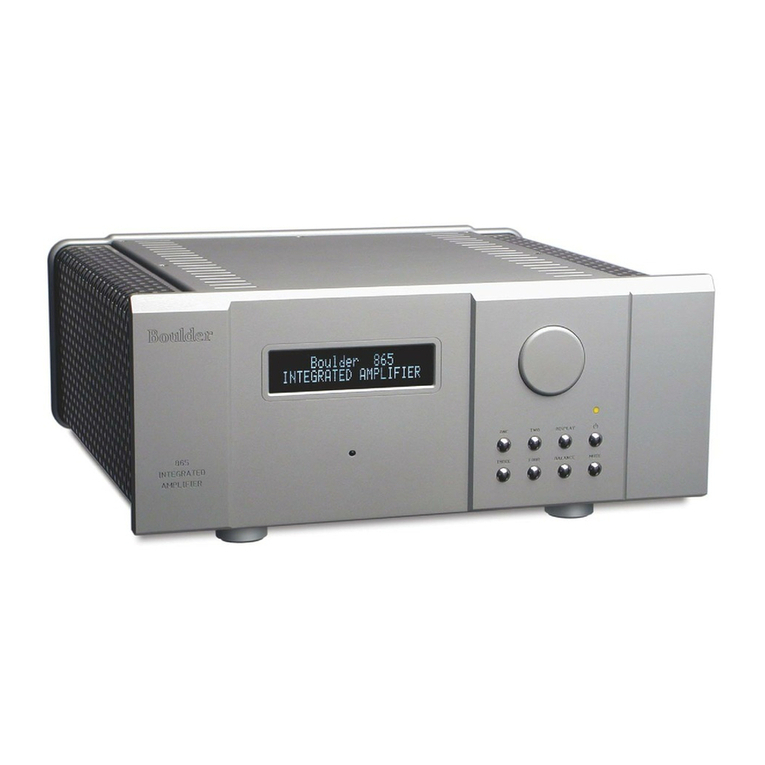
Boulder
Boulder Integrated Amplifier 865 User manual
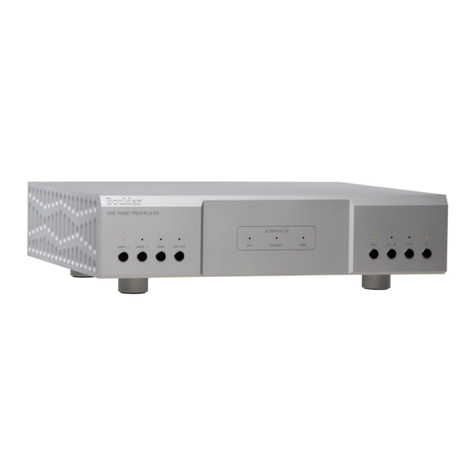
Boulder
Boulder 1008 User manual

Boulder
Boulder 1108 User manual
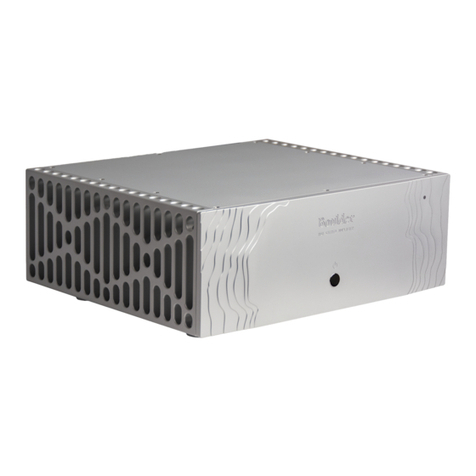
Boulder
Boulder 1161 User manual

Boulder
Boulder 3060 User manual
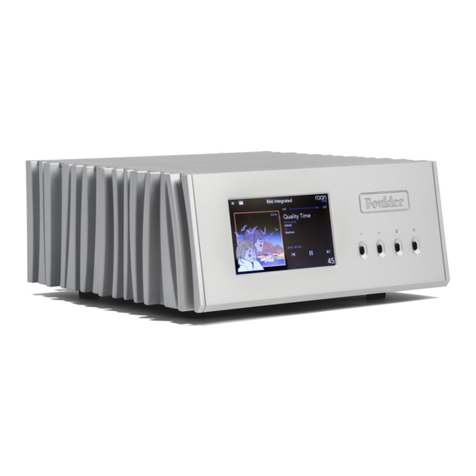
Boulder
Boulder 866 Analog User manual
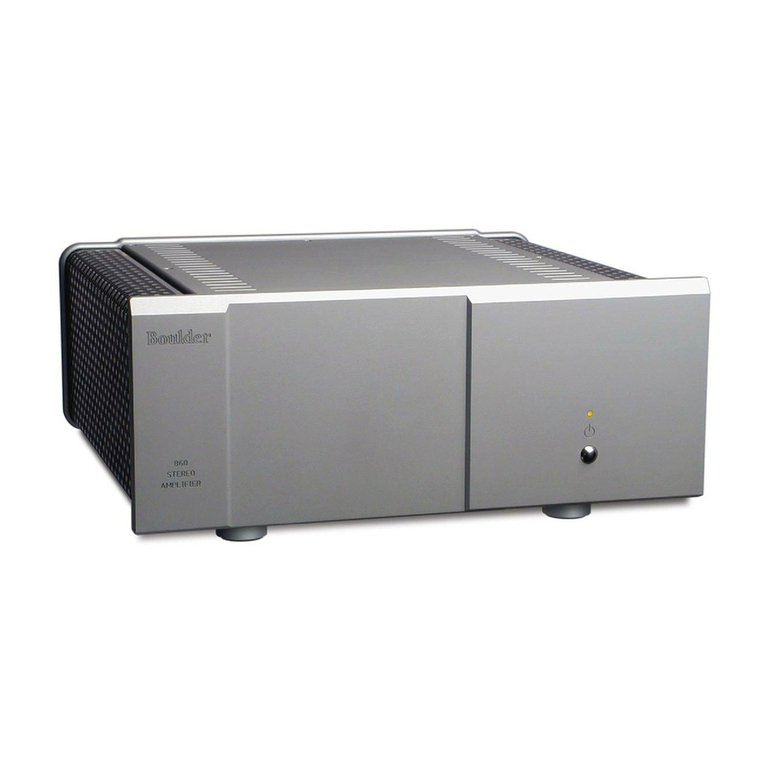
Boulder
Boulder 860 User manual
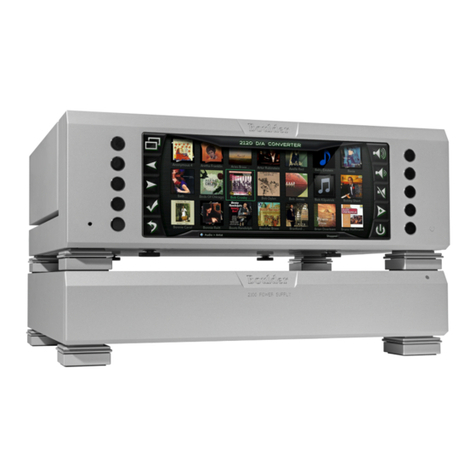
Boulder
Boulder 2120 User manual
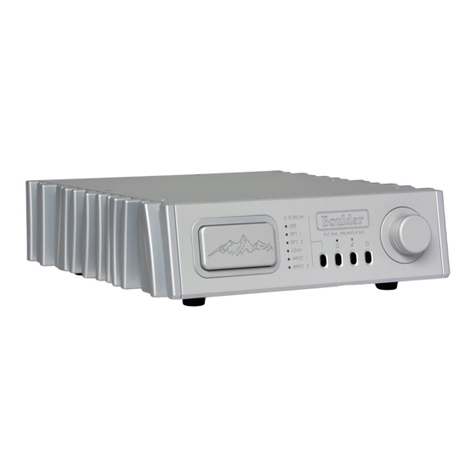
Boulder
Boulder 812 User manual

Boulder
Boulder 2010 User manual
